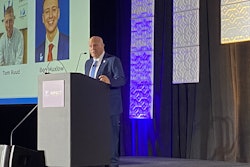In trucking, what speeds up, must slow down – sometimes quickly. There is much at stake for brake performance, literally life and death, so diligent maintenance is a must. Premature brake wear fast tracks issues ranging from revenue lost due to unexpected downtime to accidents and subsequent liability issues.
A braking system is just as strong as its weakest component. Because braking systems only function fully when every component is properly spec’d and balanced, avoiding premature brake wear means addressing the entire system, not only the failed component. An astute technician considers both external wear factors and mechanical deficiencies when undertaking quality brake maintenance and repairs.
What constitutes premature brake wear is relative. A heavy-haul application through mountainous terrain is going to wear brake components much more aggressively than, say, an LTL operation throughout the Midwest.
“Premature brake wear is a matter of application,” says Kevin Pfost, field service engineer, product specialist, Bendix Spicer Foundation Brake. “From a technician’s standpoint, premature wear would be one brake wearing out before another.”
Experts agree that there is no set time or mileage mark that indicates brakes are wearing faster than they should. “Premature wear is based on the amount of time the brakes were in service,” says Alan Matsumoto, national fleet account manager, Carlisle Motion Control Industries, Inc.
To best track normal versus irregular break wear, the lining thickness should be recorded on the inspection sheet by wheel position during routine PM inspections, recommends Matsumoto. This information then should be recorded into a database where it will show up on a frequency report if repairs arise abnormally.
Even if a braking system is perfectly tuned with all components in proper working order, there are certain external influences that put a heavier-than-normal strain on the componentry. Improper technique when braking downhill, for example, generates a large amount of heat, as does an afternoon spent navigating urban stop-and-go traffic.
“Keep in mind, the brake is a heat generator. How well you control the heat will have an effect on the lifespan of the brake,” says Matsumoto.
Brake drums are affected if brakes are generating an abnormal amount of heat, as are wheel seals, bearings and everything else on the wheel end. Often, this damage exists for a long time before a driver realizes that something is wrong. Carefully check all wheel-end components at every PM interval. Look for trouble signs such as drum hot spotting and cracking as evidence of a high-heat situation. Don’t let your customer wait for a failed emergency braking occurrence to tell him that his brakes are worn.
FACTOR IN FRICTION
Proper friction material selection and replacement is another PM cornerstone that has a strong bearing on braking system health. Lining marketed for over-the-road operating is designed under the assumption that brake temperatures will be relatively low. If the vehicle suddenly switches to a vocation that requires frequent stopping, the brakes will generate more heat, which puts unanticipated stress on the lining that it may not be able to absorb.
“Improper friction material selection can increase or decrease the frequency of replacement of either the drum or brake shoes, sometimes both,” says Matsumoto. “There are fleets that specify a 23k material for over-the-road applications, but they don’t realize that the material doesn’t actually rate 23k unless the brake power (or AL factor) is 180. A true 23k-rated material with a 165 AL factor actually would cause flat-spotting of the tires when the trailer is empty.”
Always replace friction material with exactly what is on the truck. If you encounter a vehicle with a leaky wheel seal and you change the brake out on one side and not the other, the friction material on one brake may be rendered less effective – and that causes balance issues.
“Sometimes you hear a technician talk about ‘like’ brake lining,” warns Pfost. “You always should use the exact same lining with the exact same part number. We (Bendix Spicer) wouldn’t even use our own brake lining with different friction material on the same truck.
“Sometimes we have a customer that for some odd reason has a brake chamber that’s hung up a little bit and consequently, has worn one wheel end down. When you service this truck, you really need to service the complete axle, not just the single wheel end,” Pfost continues. “I understand that the other end still has good brakes on it, but here again with the difference in friction material, if you have to install a different friction material, at least that one complete axle has to have the same friction material so you don’t get a mismatch.”
The golden rule of brake maintenance is to keep everything appropriately spec’d, matched and balanced. When you perform a brake job, don’t just replace the shoes. You also need to make sure that the bushings are properly maintained and in working order and that the cam shaft still is within spec. Check cam run outs and radial play and remember that it’s always a good idea to change the bushings and grease seals with every brake job.
Because premature brake wear ultimately is a balance issue, it is a significant safety factor. Faulty brake jobs that result in accidents can fall back on your shoulders if you’re found libel. Protect yourself, your customer and others on the road; remember that although it can be ambiguous, premature brake wear is a clear sign that something either isn’t spec’d correctly or working properly. Always conduct exhaustive brake component investigations. It’s worth your time and your customers’.
What You Can Mix
Experts agree that mixing drum and disc brakes on tractors and trailers does not cause premature brake wear. But, if the brake balance is not established properly, wear will occur. When mixing drum and disc brakes, closely watch relay valve crack pressure differentials and keep the tire size between tractor and trailer in check.
Don’t Tinker With That ASA
Automatic slack adjustors (ASA) adjust the clearance between brake shoes and the drum to compensate for lining wear; don’t neglect its potential role in preventing excessive brake wear. Most professionals have heard by now that ASAs should not need manual adjustment. If you find it necessary to adjust an ASA, foundation brake components could be out-of-spec or the ASA might be installed improperly or not working correctly. If, after a careful inspection, you determine that all the individual brake components are up to par, consider that the ASA’s internal adjustment mechanism might need replacing, or that the pushrod setup could be too long.







